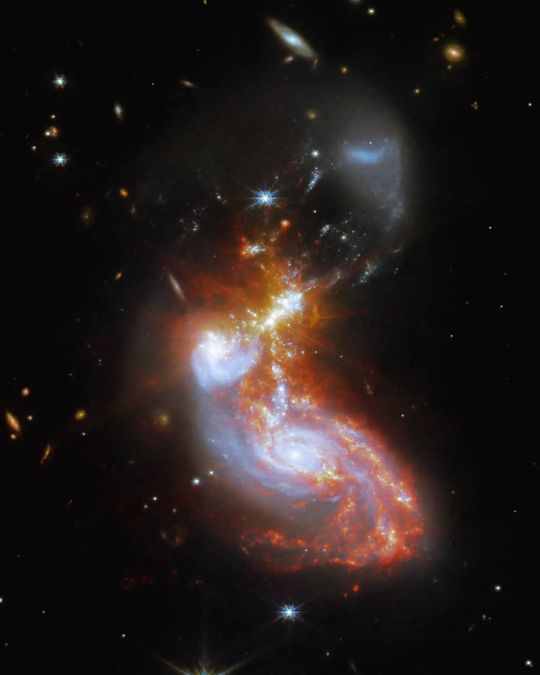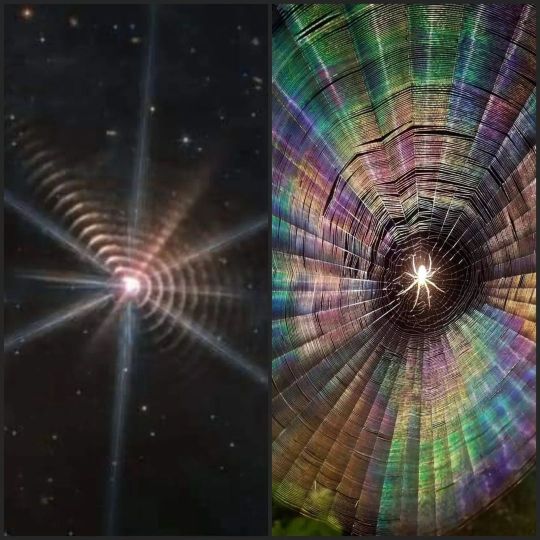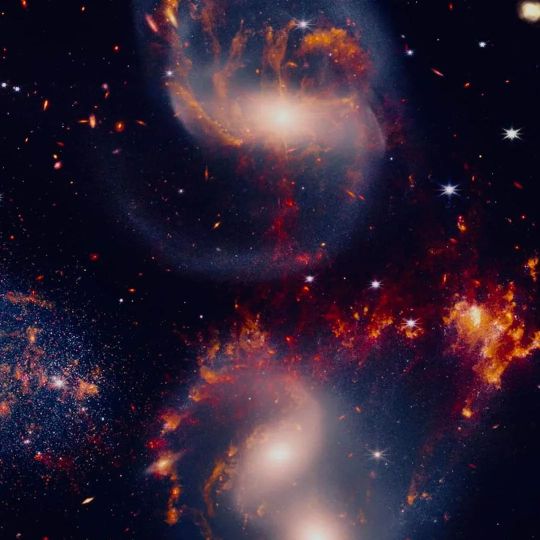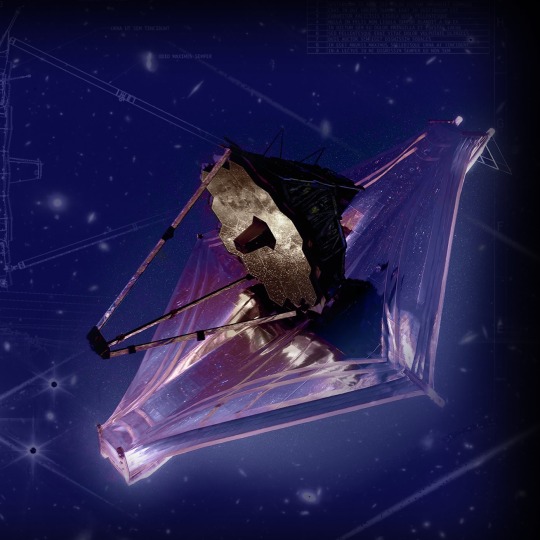Photo

A cropped close-up of the James Webb Space Telescope image of two merging galaxies known as ZW II 96 (also II Zw 96). . . . . . . . . A merging galaxy pair cavort in this image captured by the NASA/ESA/CSA James Webb Space Telescope. This pair of galaxies, known to astronomers as II ZW 96, is roughly 500 million light-years from Earth and lies in the constellation Delphinus, close to the celestial equator. As well as the wild swirl of the merging galaxies, a menagerie of background galaxies are dotted throughout the image. The two galaxies are in the process of merging and as a result have a chaotic, disturbed shape. The bright cores of the two galaxies are connected by bright tendrils of star-forming regions, and the spiral arms of the lower galaxy have been twisted out of shape by the gravitational perturbation of the galaxy merger. It is these star-forming regions that made II ZW 96 such a tempting target for Webb; the galaxy pair is particularly bright at infrared wavelengths thanks to the presence of the star formation. This observation is from a collection of Webb measurements delving into the details of galactic evolution, in particular in nearby Luminous Infrared Galaxies such as II ZW 96. These galaxies, as the name suggests, are particularly bright at infrared wavelengths, with luminosities more than 100 billion times that of the Sun. An international team of astronomers proposed a study of complex galactic ecosystems — including the merging galaxies in II ZW 96 — to put Webb through its paces soon after the telescope was commissioned. Their chosen targets have already been observed with ground-based telescopes and the NASA/ESA Hubble Space Telescope, which will provide astronomers with insights into Webb’s ability to unravel the details of complex galactic environments. Webb captured this merging galaxy pair with a pair of its cutting-edge instruments; NIRCam — the Near-InfraRed Camera — and MIRI, the Mid-InfraRed Instrument. If you are interested in exploring the differences between Hubble and Webb’s observations of II ZW 96, you can do so here. #jameswebbspacetelescope #WebbDepot #JWST #Webb #nasawebb #unfoldtheuniverse #JWSTWebb #NASA #ESA https://www.instagram.com/p/Clmz8hhjtu9/?igshid=NGJjMDIxMWI=
13 notes
·
View notes
Photo

270 million light-years away, a pair of entwined galaxies are colliding together, creating new stars at a rate more than 20 times that of our Milky Way. Webb's latest image shines a new light on these interacting galaxies. Credit: ESA/Webb, NASA & CSA #jameswebbspacetelescope #WebbDepot #JWST #Webb #nasawebb #unfoldtheuniverse #JWSTWebb #NASA #ESA #CSA #Northrop #NorthropGrumman #webbtelescope #space #cosmos #astronomy #gift #astrophysics #universe #spiralgalaxy #hubble #galaxy #astrophotography #solarsystem #nebula #physics #science #present #holiday #stars https://www.instagram.com/p/CkQlbvxAsZx/?igshid=NGJjMDIxMWI=
#jameswebbspacetelescope#webbdepot#jwst#webb#nasawebb#unfoldtheuniverse#jwstwebb#nasa#esa#csa#northrop#northropgrumman#webbtelescope#space#cosmos#astronomy#gift#astrophysics#universe#spiralgalaxy#hubble#galaxy#astrophotography#solarsystem#nebula#physics#science#present#holiday#stars
1 note
·
View note
Photo

10% off with code TENOFF2022 Find so much more at @webbdepot . . . . . #jameswebbspacetelescope #WebbDepot #JWST #Webb #nasawebb #unfoldtheuniverse #JWSTWebb #NASA #ESA #CSA #Northrop #NorthropGrumman #webbtelescope #space #cosmos #astronomy #gift #astrophysics #universe #spiralgalaxy #hubble #galaxy #astrophotography #solarsystem #nebula #physics #science #present #holiday #mug https://www.instagram.com/p/CkHoxpGDCqa/?igshid=NGJjMDIxMWI=
#jameswebbspacetelescope#webbdepot#jwst#webb#nasawebb#unfoldtheuniverse#jwstwebb#nasa#esa#csa#northrop#northropgrumman#webbtelescope#space#cosmos#astronomy#gift#astrophysics#universe#spiralgalaxy#hubble#galaxy#astrophotography#solarsystem#nebula#physics#science#present#holiday#mug
0 notes
Photo

Webb can expect to find mostly low-water, rocky exoplanets. Modelling shows that the probabilities of three very-different looking types of terrestrial planets (covered with land, ocean or an equal mix of both) vary widely, while highly impacting their climate and thus their habitability. Credit: Europlanet 2024 RI/T. Roger. Earth-like exoplanets unlikely to be another ‘pale blue dot’ When searching for Earth-like worlds around other stars, instead of looking for the ‘pale blue dot’ described by Carl Sagan, new research suggests that a hunt for dry, cold ‘pale yellow dots’ might have a better chance of success. The near balance of land-to-water that has helped life flourish on Earth could be highly unusual, according to a Swiss-German study presented at the Europlanet Science Congress 2022 in Granada. source https://www.europlanet-society.org/earth-like-exoplanets-unlikely-to-be-another-pale-blue-dot/ #JWST #Webb #nasawebb #unfoldtheuniverse #JWSTWebb #NASA #ESA #CSA #Northrop #NorthropGrumman #webbtelescope #WebbDepot #space #cosmos #astronomy #astrophysics #universe #exoplanet #spiralgalaxy #hubble #galaxy #astrophotography #telescope #exoplanets #spacetime #solarsystem #nebula #physics #science #jameswebbspacetelescope https://www.instagram.com/p/Cjg526-jiMA/?igshid=NGJjMDIxMWI=
#jwst#webb#nasawebb#unfoldtheuniverse#jwstwebb#nasa#esa#csa#northrop#northropgrumman#webbtelescope#webbdepot#space#cosmos#astronomy#astrophysics#universe#exoplanet#spiralgalaxy#hubble#galaxy#astrophotography#telescope#exoplanets#spacetime#solarsystem#nebula#physics#science#jameswebbspacetelescope
1 note
·
View note
Photo

A glitch has been detected in one of Webb's seventeen observation modes. It's unclear at this time how severe the problem is. The specific mode, known as the Medium-Resolution Spectroscopy (MRS) had experienced an issue characterized as 'increased friction' Here is the Operations Update from NASA: The James Webb Space Telescope’s Mid-Infrared Instrument (MIRI) has four observing modes. On Aug. 24, a mechanism that supports one of these modes, known as medium-resolution spectroscopy (MRS), exhibited what appears to be increased friction during setup for a science observation. This mechanism is a grating wheel that allows scientists to select between short, medium, and longer wavelengths when making observations using the MRS mode. Following preliminary health checks and investigations into the issue, an anomaly review board was convened Sept. 6 to assess the best path forward. The Webb team has paused in scheduling observations using this particular observing mode while they continue to analyze its behavior and are currently developing strategies to resume MRS observations as soon as possible. The observatory is in good health, and MIRI’s other three observing modes – imaging, low-resolution spectroscopy, and coronagraphy – are operating normally and remain available for science observations. Cresit Thaddeus Cesari, NASA. Sources: https://blogs.nasa.gov/webb/2022/09/20/mid-infrared-instrument-operations-update/ https://blogs.nasa.gov/webb/2022/05/12/seventeen-modes-to-discovery-webbs-final-commissioning-activities/ #JWST #Webb #nasawebb #unfoldtheuniverse #JWSTWebb #NASA #ESA #CSA #Northrop #NorthropGrumman #webbtelescope #WebbDepot #space #cosmos #astronomy #astrophysics #universe #spiralgalaxy #hubble #galaxy #astrophotography #telescope #stars #solarsystem #nebula #physics #MIRI #jameswebbspacetelescope https://www.instagram.com/p/CiwbHt1gJcP/?igshid=NGJjMDIxMWI=
#jwst#webb#nasawebb#unfoldtheuniverse#jwstwebb#nasa#esa#csa#northrop#northropgrumman#webbtelescope#webbdepot#space#cosmos#astronomy#astrophysics#universe#spiralgalaxy#hubble#galaxy#astrophotography#telescope#stars#solarsystem#nebula#physics#miri#jameswebbspacetelescope
0 notes
Photo

Webb set it's sight on Mars! Webb has captured its first infrared spectrum of Mars , providing a unique perspective on our neighbouring planet, that compliments data collected by orbiters, rovers, and other telescopes. This near-infrared spectrum of Mars was captured by the Near-Infrared Spectrograph (NIRSpec) on 5 September 2022, over 3 slit gratings (G140H, G235H, G395H). The spectrum is dominated by reflected sunlight at wavelengths shorter than 3 microns and thermal emission at longer wavelengths. The spectral dips appear at specific wavelengths where light is absorbed by molecules in Mars’ atmosphere, specifically carbon dioxide, carbon monoxide, and water. Analysis of the spectrum can tell scientists about the abundance of these molecules. From its unique vantage point, L2, Webb can capture spectra with the resolution needed to study phenomena like dust storms, weather patterns, seasonal changes, and processes that occur at different times of a Martian day. Read more: http://ow.ly/lZ9e50KMNrN #WebbSeesFarther NASA - National Aeronautics and Space Administration ESA - European Space Agency Canadian Space Agency and STScI, Mars JWST/GTO team #JWST #Webb #nasawebb #unfoldtheuniverse #JWSTWebb #NASA #ESA #CSA #Northrop #NorthropGrumman #WebbDepot #cosmos #astronomy #astrophysics #universe #spiralgalaxy #galaxy #astrophotography #telescope #mars #solarsystem #sciencehumor #jameswebbspacetelescope https://www.instagram.com/p/CitER5GrUD-/?igshid=NGJjMDIxMWI=
#webbseesfarther#jwst#webb#nasawebb#unfoldtheuniverse#jwstwebb#nasa#esa#csa#northrop#northropgrumman#webbdepot#cosmos#astronomy#astrophysics#universe#spiralgalaxy#galaxy#astrophotography#telescope#mars#solarsystem#sciencehumor#jameswebbspacetelescope
1 note
·
View note
Photo

The James Webb Space Telescope will be located at L2 #jwst https://www.instagram.com/p/B9k7BkOnm5N/?igshid=NGJjMDIxMWI=
2 notes
·
View notes
Photo

During assembly and testing #jwst #jameswebbspacetelescope https://www.instagram.com/p/B-KIQTDHIAX/?igshid=NGJjMDIxMWI=
1 note
·
View note
Photo

It's about a year away from launch! #cantwait #jameswebbspacetelescope #jwst #webbtelescope https://www.instagram.com/p/B-ewmU5nbY7/?igshid=NGJjMDIxMWI=
0 notes
Photo

“The James Webb Space Telescope achieved another significant milestone with the entire observatory in its launch configuration for the first time, in preparation for environmental testing,” said Bill Ochs, Webb project manager for NASA Goddard Space Flight Center in Greenbelt, Maryland. . . . . . #jameswebbspacetelescope #jwst #webbtelescope #nasawebb https://www.instagram.com/p/CAPQF1gn0YL/?igshid=NGJjMDIxMWI=
0 notes
Photo

With giant storms, powerful winds, auroras, and extreme temperature and pressure conditions, Jupiter has a lot going on. Now, NASA’s James Webb Space Telescope has captured new images of the planet. Webb’s Jupiter observations will give scientists even more clues to Jupiter’s inner life. https://www.instagram.com/p/ChscQSIJBPq/?igshid=NGJjMDIxMWI=
0 notes
Photo

Tarantula Nebula by The James Webb Space Telescope https://www.instagram.com/p/CiLvYzGsO0B/?igshid=NGJjMDIxMWI=
0 notes
Photo

The James Webb Space Telescope took the image on the left. A spider's Webb on the right. The binary star is called WR140 and is surrounded by ripples that fade away as they move further away from the source. The Universe, truly, is full of wonders, and the James Webb Space Telescope has just given us our best views of one of them yet. The object in question is a star around 5,600 light-years away, and Webb's infrared eye has picked out an extraordinary detail: it's surrounded by what appear to be concentric rings of light radiating outward. While Webb's characteristic diffraction spikes are not 'real', those concentric rings are – and there's a wonderful and fascinating explanation for them. The star is actually a binary pair of rare stars in the constellation of Cygnus, and their interactions produce precise periodic eruptions of dust that are expanding out in shells into the space around the pair over time. These shells of dust are glowing in infrared, which has allowed an instrument as sensitive as Webb's MIRI to resolve them in exquisite detail. Credit: NASA, ESA, CSA, and STScI / Judy Schmidt #jwstwebb #webb #jameswebbspacetelescope #nasawebb #unfoldtheuniverse https://www.instagram.com/p/CiOv6dHDEhT/?igshid=NGJjMDIxMWI=
0 notes
Photo

Carina Nebula by The James Webb Space Telescope. Beautiful Nebula #JWST #jameswebbspacetelescope #jwstwebb #unfoldtheuniverse #carinanebula https://www.instagram.com/p/CiOx-KzMtzI/?igshid=NGJjMDIxMWI=
0 notes
Photo

I can't stop staring at these images from The James Webb Space Telescope. . . . . This is a close-up image of Stephan’s Quintet, with the contrast adjusted a little to make the individual stars in the galaxies pop a little more. #jwst #jameswebbspacetelescope #nasawebb #jwstwebb #unfoldtheuniverse #webbsfirstimages #stephansquintet https://www.instagram.com/p/Chyq7x3sagS/?igshid=NGJjMDIxMWI=
0 notes
Photo
The Tarantula Nebula
Credit NASA

Tarantula Stars R136 © JWST
3K notes
·
View notes
Text

The James Webb Space Telescope (JWST)
Amazing!
.
.
#JWST #Webb #nasawebb #unfoldtheuniverse #JWSTWebb #NASA #ESA #CSA #Northrop #NorthropGrumman #webbtelescope #WebbDepot #space #cosmos #astronomy #astrophysics #universe #spiralgalaxy #hubble #galaxy #astrophotography #telescope #stars #astronaut #astro #solarsystem #nebula #physics #science #sciencehumor #jameswebbspacetelescope
1 note
·
View note